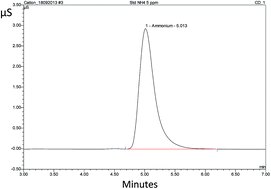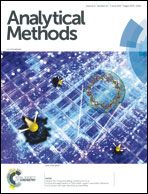Rapid determination of impurity of boron nitride in amorphous boron powder using inductively coupled plasma-atomic emission spectrometry (ICP-AES) and ion chromatography (IC)
Abstract
Ever-increasing use of amorphous boron powder (ABP) in high-energy materials (HEMs) and allied compositions has created frequent demand for the analysis of boron (B). The presence of nitrogen in inert gas (Ar) used during the synthesis of ABP or from trapped air during the process results in the formation of boron nitride in a significant quantity (up to 4%), and hence an adequate analytical method for the selective estimation of nitride content has been established. Conventionally, ABP is analyzed by fusion with sodium carbonate followed by total B-content estimation from inductively coupled plasma-atomic emission spectrometry (ICP-AES). This method of B estimation using ICP-AES is not sufficient alone to differentiate B from ABP and BN, and an alternative new analytical method was developed for the rapid and direct estimation of BN in ABP. Due to its substantial chemical inertness, decomposition of BN is extremely difficult, and therefore the digestion was attempted with several acids and acid mixtures using microwave digestion in a closed vessel at various temperatures. H2SO4 (98%), HNO3 (68–70%), HF (40%) + H2SO4, HF (40%) + HNO3, HF (40%) and HF (48%) were tried, and complete digestion of pure BN into ammonium fluoroborate (NH4BF4) was observed only with HF and HF + HNO3. The results were then compared with those obtained with alkaline carbonate (Na2CO3) fusion. Digestion with HF alone using microwaves is suitable for the direct estimation of BN as a minor ingredient or impurity in ABP and other B-based materials using ion chromatography (IC). Microwave-acid digestion decomposed samples at elevated temperatures (∼200 °C) with a short heating time (∼10 min) with a small quantity of reagents (∼3 ml) compared with conventional methods. The extent of the decompositions at different temperatures was monitored and studied by estimating B through ICP-AES and ammonium ions by IC. The proposed microwave digestion method using HF followed by ICP-AES/IC analysis is equally applicable for analyzing BN as a major component, and has also been applied successfully for analyzing boron carbide (B4C) and is well suited for other refractory compounds.



 Please wait while we load your content...
Please wait while we load your content...